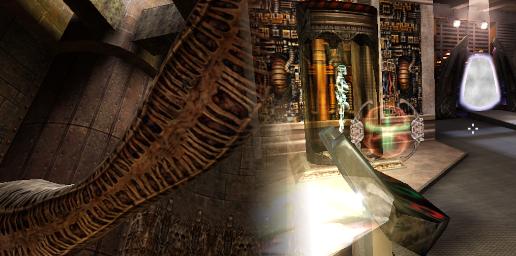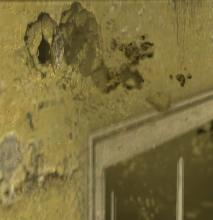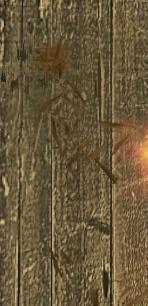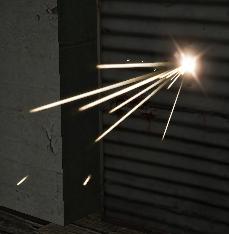 |
Nuclide
Software Development Kit for id Technology (BETA)
|
 |
Nuclide
Software Development Kit for id Technology (BETA)
|
Materials, also formerly known Q3 shaders or wrongly referred to as just shaders are scripts that define texture and surface properties.
In the id Tech series of engines, id Tech 3/Quake III Arena was the first to introduce such a system, wrongly referred to back then as shaders. This was before vertex and fragment shaders were commonplace in the video-game asset pipeline.

They effectively merged the Quake texture-prefix based hacks and Quake II .wal surface flags into one plain text format.
Starting with id Tech 4/Doom III in 2004, the name of shader was changed to material to avoid confusion with proper GPU oriented vertex and fragment shaders.
FTEQW has since coupled the old 'shader' syntax with proper GPU shaders using the program material command.
Materials are short text scripts that define the properties of a surface as it both appears and functions in the game world.
If you want your sky texture to be replaced with a skybox, you will have to write a material definition for that.
If you want to have a surface that looks and acts like water, then you have to write a material for that too. Unlike earlier id Tech games no assumption over a surface should be made based on texture names alone.
Then you can still use modern materials! While the engine may load a texture from a bsp or wad file directly, it will still (albeit internally) create a material for it.
When ingame, look at your surface you want to replace with the console variable r_showshaders set to 1 - and you will see the path and the contents of the material you're looking at. You can use that information to override rendering for practically any surface, even when using old fileformats.
When the engine looks for a texture, it will look for a material file in the filesystem first, then it will attempt to 'make one up' if only an image file is present. A renderable surface will always have a material. The question is whether you provide it, or if the engine has to automatically generate one internally.
The file extension for materials in Nuclide is .mat. There are two ways of defining materials:
<gamedir>/scripts/ folder (not recommended)models/weapons/handcannon/w_handcannon/w_handcannon.mat handles models/weapons/handcannon/w_handcannon/w_handcannon.tgaA material file consists of a series of surface attributes (global scope) and rendering instructions formatted within braces ("{" and "}"). Below you can see a simple example of syntax and format for a single process, including the VMAP keywords or 'Surface Parameters', which follow the first bracket and a single bracketed 'stage':
The first line is a simple comment. All the official textures are marked that way.
diffusemap defines a texture sampler to associate with the material, it'll also be used by the real-time lights to render an impacted surface, hence why it's defined at a global scope. Other materials may need to be aware of it. The compiler also uses it to compute radiosity.
vmap_tessSize will tell the BSP compiler to tesselate the surface in a specific way. This affects the entire surface and not just a single rendering stage, hence why it's defined at a global scope.
We then follow into the territory of defining specific rendering instructions within braces ("{" and "}"), most of the time that's not needed if we're defining a simple, opaque material. However in this case we want to make sure that we have 1 rendering stage that blends additively. Things such as real-time lights and the BSP compiler ignore these additional stages entirely.
program unlit will tell it not to be affected by lighting and just use a simple fullbright shader.
blendFunc add will now tell the renderer that this surface is no longer opaque and will be blended with whatever equation will result in an additive blend.
You can read more about those commands in detail right here.
If no material definition for a surface is present, the engine will create an internal one. It's generally a primitive material using the internal defaultwall shader if it's a world texture, the defaultskin texture if it's a model, or a default2d if it's a HUD element.
You can support old-style Q3A materials alongside modern shader oriented ones.
Here everything inside the if $programs block will only ever load if it's capable of handling the GLSL. So if the player has a card that does not support programmable shaders, the else path will take over.
In the GoldSrc games "Material" definitions handle what footsteps and what impact sounds are played against each texture in the game-world.

So when you walk on dirt, you can hear the difference; or when you shoot wood with a gun it will sound like wood.
Note: While Nuclide supports this for legacy BSP files, please define the surface properties inside your material using the surfaceprop command.
Usually, a game in the GoldSrc engine would provide a sound/materials.txt file, where each line defines the properties for a single (or a series of) textures by starting with a material id character, followed by whitespace, followed by a name matching pattern.
For example:
C CONCRETEWALL
Will give any surface the id C if it starts with the name CONCRETEWALL.
It will also only compare the length of characters of the name above. So for example if you were to define:
C CONC
Then CONCRETEWALL would still be marked as concrete, and any other texture that starts with CONC[...].
Note: In vanilla Half-Life, the second argument (name) can only be 12 characters long.
When you then walk around your level, the footstep will then be aware of you being on a texture marked with the C attribute and play a different step sound. Games are free to define what those material id characters mean - so different games/mods may interpret it differently.
Porting levels can sometimes be a bit more work than it first appears to be at first glance as a result!
In stock GoldSrc games, the sound/materials.txt can be overwritten by a modification but it couldn't be dynamically extended in any way. This means there was no possibility of map specific materials, and mods could not inherit Half-Life's materials, so mods would always have to manage a nearly duplicate file if they desired custom material definitions.
A few mods tried to remedy this problem, the following below are methods documented so far:
file named maps/MAPNAME.mat : Introduced in The Wastes (2003)
file named maps/MAPNAME_materials.txt : Convention by Andrew Lucas, creator of Trinity SDK, modeled after MAPNAME_details.txt
worldspawn entity key named 'materials_file' with the value PATH_TO/FILE.txt : Introduced in Sven Co-op 5.0
All these methods are supported by Nuclide, as one goal is to implement conventions by not only Valve but the community as well!
In addition Nuclide has also implemented a way of giving modifications their own inheritable materials file:
sounds/materials_UNIQUENAME.txt
The idea here is that any mod or even map pack can include ONLY the textures used, and no longer will anyone have to manage a near-clone of sound/materials.txt.
For repackaging or modding purposes, if you desire to give your map custom material property definitions, we recommend The Wastes its method for individual maps, while the Nuclide method should be used for mods or map packs.
Note: We recommend only using material text files for GoldSrc related modding purposes. It is inefficient for modern projects as there are much better standards already supported in Nuclide.
In Nuclide, this is the currently supported list of material IDs:
| Material ID | Material Name |
|---|---|
| B | Bloody Flesh |
| C | Concrete |
| D | Dirt |
| F | Flesh |
| G | Grate |
| H | Alien |
| K | Snow |
| M | Metal |
| N | Sand |
| O | Foliage |
| P | Computer |
| S | Slosh |
| T | Tile |
| V | Vent |
| W | Wood |
| Y | Glass |
Different games/mods can ship with different material properties. To make your life easier, you can edit scripts/surfaceproperties.txt and define which Material ID character maps to which surfaceproperty entry. This way you can add new materials to existing legacy maps without writing a line of code.
Listed below are definitions for various games and mods. Only the changes and additions are listed since the rest are identical.
| Material ID | Material Name |
|---|---|
| B | Blue Texture |
| N | Snow |
| R | Red Texture |
| U | Slime |
| X | Yellow Texture |
| Z | Black Texture |
| Material ID | Material Name |
|---|---|
| N | Snow |
| X | Grass |
Afraid of Monsters: DC, Natural Selection, and Snow War uses the same definitions.
| Material ID | Material Name |
|---|---|
| B | Random Twig Snap |
| H | Paper |
| I | Mud |
| O | Sand |
| P | Snow |
| R | Gravel |
| U | Grass |
| Y | Broken Glass |
| Z | Carpet |
| Material ID | Material Name |
|---|---|
| G | Wood |
| T | Rock |
| V | Sand |
| W | Unknown/Unused? |
| Material ID | Material Name |
|---|---|
| B | Sandbag |
| N | Snow |
| U | No impact or decals, just smoke effects |
| Material ID | Material Name |
|---|---|
| U | Mud |
| Material ID | Material Name |
|---|---|
| A | Sand |
| E | Foliage |
| N | Snow |
| R | Carpet |
| U | Mud |
| Z | Grass |
| Material ID | Material Name |
|---|---|
| H | Wood (Creaky) |
| I | Grass |
| Material ID | Material Name |
|---|---|
| T | Carpet |
| Material ID | Material Name |
|---|---|
| O | Snow |
Science and Industry uses the same definitions as Opposing Force.
| Material ID | Material Name |
|---|---|
| M | Metal/Grate |
| T | Wood/Tile |
| G | Carpet/Grass |
| Material ID | Material Name |
|---|---|
| B | Barrel |
| I | Sand |
| N | Tinroof |
| R | Rust |
| U | Drywall |
The Wastes uses the same definitions.
While Source has materials describing a surface with its own $surfaceprop command, the GoldSrc way of describing materials with a 1-character symbol is still used to define which impact effect to use.
The Material ID is used via the gamematerial command inside scripts/surfaceproperties.txt entries. In Nuclide that's used for compatibility with the GoldSrc system instead.



Be aware that a Source engine game may actually have more surface materials than this, these are solely the IDs associated with impact effects.
| Material ID | Material Name |
|---|---|
| 11 | Steam Pipe |
Alien Swarm: Reactive Drop uses the same definitions.
| Material ID | Material Name |
|---|---|
| 11 | Mud |
| 12 | Sand Barrel |
| 13 | Sand Barrel (Penetration) |
| 14 | Metal Shield |
| Material ID | Material Name |
|---|---|
| A | Antlion |
| B | Flesh (Bloody) |
| H | Flesh (Antlion) |
| K | Snow |
| L | Plastic |
| N | Sand |
| I | Clip |
| O | Foliage |
| X | Fake |
| - | No Decal |
| Material ID | Material Name |
|---|---|
| E | Antlion Egg Sacks |
| Z | Adviser Shield |
| Material ID | Material Name |
|---|---|
| A | Fruit |
Day of Infamy uses the same definitions.
| Material ID | Material Name |
|---|---|
| J | Grass |
| K | Mud |
| Q | Asphalt |
| R | Brick |
| U | Cardboard |
| 1 | Clay |
| 2 | Plaster |
| 3 | Rock |
| 4 | Rubber |
| 5 | Sheetrock |
| 6 | Cloth |
| 7 | Carpet |
| 8 | Paper |
| 9 | Upholstery |
| 10 | Puddle |
| Material ID | Material Name |
|---|---|
| R | Reflective |